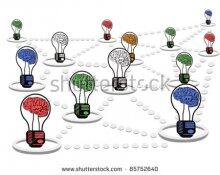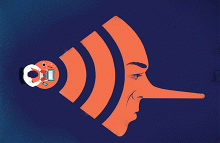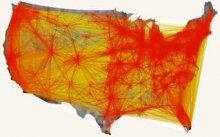People influence each other when they interact to solve problems. Such social influence introduces both benefits (higher average solution quality due to exploitation of existing answers through social learning) and costs (lower maximum solution quality due to a reduction in individual exploration for novel answers) relative to independent problem solving. In contrast to prior work, which has focused on how the presence and network structure of social influence affect performance, here we investigate the effects of time. We show that when social influence is intermittent it provides the benefits of constant social influence without the costs. Human subjects solved the canonical traveling salesperson problem in groups of three, randomized into treatments with constant social influence, intermittent social influence, or no social influence. Groups in the intermittent social-influence treatment found the optimum solution frequently (like groups without influence) but had a high mean performance (like groups with constant influence); they learned from each other, while maintaining a high level of exploration. Solutions improved most on rounds with social influence after a period of separation. We also show that storing subjects’ best solutions so that they could be reloaded and possibly modified in subsequent rounds - a ubiquitous feature of personal productivity software - is simiar to constant social influence: It increases mean performance but decreases exploration.
Publications
2018
The rise of fake news highlights the erosion of long-standing institutional bulwarks against misinformation in the internet age. Concern over the problem is global. However, much remains unknown regarding the vulnerabilities of individuals, institutions, and society to manipulations by malicious actors. A new system of safeguards is needed. Bwlow, we discuss extant social and computer science research regarding belief in fake news and the mechanisms by which it spreads. Fake news has a long history, but we focus on unanswered scientific questions raised by the proliferation of its most recent, politically oriented incarnation. Beyond selected references in the text, suggested further reading can be found in the supplementary materials.
2017
We know a lot about fake news. It’s an old problem. Academics have been studying it - and how to combat it - for decades. In 1925, Harper’s Magazine published "Fake News and the Public," calling it’s spread via new communication technoloies "a source of unprecedented dange." That danger has only increased. Some of the most shared "news stories" from the 2016 U.S. election - such as Hillary Clinton selling weapons to Islamic State or the pope endorsing Donald Trump for president - were simply made up.
In politics, it’s become conventional wisdom that talking seriously to regular Americans doesn’t really pay off. Numerous studies have found that citizens appear to dig in their heels, resisting information that contradicts their beliefs - if they’re informed enough to have meaningful beliefs in the first place. When politicians talk to voters, the goal is usually to rev up their base, or shift a tiny wedge of the "undecided," rather to genuinely persuade a broad swath of the public. This might be a discouraging view of how politics works, but it’s also seen as realistic. If Americans aren’t persuadable, there’s little sense in members of Congress wasting their time trying to have meaningful conversations about the future of the country. This view is also mostly wrong.
"A large body of literature claims that oil production increases the risk of civil war. However, a growing number of skeptics argue that the oil-conflict link is not casual, but merely an artifact of flawed research designs. This article reevaluates whether - and where - oil causes conflict by employing a novel identification strategy based on the geological determinants of hydrocarbon reserves. We employ geospatial data on the location of sedimentary basins as a new spatially disaggregated instrument for petroleum production. Combined with newly collected data on oil field locations, this approach allows investigating the causal effect of oil on conflict at the national and sub-national levels. Contrary to the recent criticism, we find that previous work has underestimated the magnitude of the conflict-inducing effect of oil production. Our results indicate that oil has a large and robust effect on the likelihood of secessionist conflict, especially if it is produced in populated areas. In contrast, oil production does not appear to be linked to center-seeking civil wars. Moreover, we find considerable evidence in favor of an ethno-regional explanation of this link. Oil production significantly increases the risk of armed secessionism if it occurs in the settlement areas of ethnic minorities."
This study reports the results of a multiyear program to predict direct executive elections in a variety of countries from globally pooled data. We developed prediction models by means of an election data set covering 86 countries and more than 500 elections, and a separate data set with extensive polling data from 146 election rounds. We also participated in two live forecasting eperiments. Our models correctly predicted 80 to 90% of elections in out-of-sample tests. The results suggest that global elections can be successfully modeled and that they are likely to become more predictable as more information becomes available in future elections. The results provide strong evidence for the impact of political institutions and incumbent advantage. They also provide evidence to support contentions about the importance of international linkage and aid. Direct evidence for economic indicators as predictors of election outcomes is relatively weak. The results suggest that with some adjustments, global polling is a robust predictor of election outcomes, even in developing states. Implications of these findings after the latest U.S. presidential election are discussed.
We examine the social antecedents of contributing to campaigns, with a particular focus on the role of population density and social networking opportunities. Using 10 years of US campaign contribution data from the Federal Election Commission and a national survey of party leaders, we find that recruiting contributors is easier in a densely populated region, where the daily opportunity of individuals being exposed to the same information via their social networks is high. Furthermore, the effect of population density is heterogeneous with respect to mobility: if a region has substantial commuting outflow, the chance of being mobilized from the place of residence decreases, but the chance of mobilization in their place of work increases. This analysis also reveals differences between political parties. Democrats are more dependent on social netowrking in population dense areas. This difference in the importance of social networking opportunities present in geographical space helps explain macro-level patterns in party fundraising.
Many companies have proprietary resources and/or data that are indispensable for research, and academics provide the creative fuel for much early-stage research that leads to industrial innovation. It is essential to the health of the research enterprise that collaborations between industrial and university researchers flourish. This system of collaboration is under strain. Financial motivations driving product development have led to concerns that industry-sponsored research comes at the expense of transparency (1). Yet many industry researchers distrust quality control in academia (2) and question whether academics value reproducibility as much as rapid publication. Cultural differences between industry and academia can create or increase difficulties in reproducing research findings. We discuss key aspects of this problem that industry-academia collaborations must address and for which other stakeholders, from funding agencies to jorunals, can provide leadership and support.
Manual annotations are a prerequisite for many applications of machine learning. However, weaknesses in the annotation process itself are easy to overlook. In particular, scholars often choose what information to give to annotators without examining these decisions empirically. For subjective tasks such as sentiment analysis, sarcasm, and stance detection, such choices can impact results. Here, for the task of political stance detection on Twitter, we show that providing too little context can result in noisy and uncertain annotations, whereas providing too strong a context may cause it to outweigh other signals. To characterize and reduce these biases, we develop ConStance, a general model for reasoning about annotations across information conditions. Given conflicting labels produced by multiple annotators seeing the same instances with different contexts, ConStance simultaneously estimates gold standard labels and also learns a classifier for new instances. We show that the classifier learned by ConStance outperforms a variety of baselines at predicting political stance, while the model’s interpretable parameters shed light on the effects of each context.
The present work proposes the use of social media as a tool for better understanding the relationship between a journalists’ social network and the content they produce. Specifically, we ask: what is the relationship between the ideological leaning of a journalist’s social network on Twitter and the news content he or she produces? Using a novel dataset linking over 500,000 news articles produced by 1,000 journalists at 25 different news outlets, we show a modest correlation between the ideologies of who a journalist follows on Twitter and the content he or she produces. This research can provide the basis for greater self-reflection among media members about how they source their stories and how their own practice may be colored by their online networks. For researchers, the findings furnish a novel and important step in better understanding the construction of media stories and the mechanics of how ideology can play a role in shaping public information.









